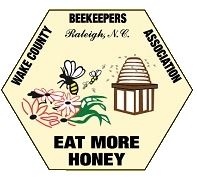 | Wake County Beekeepers Association |
Beekeeping Calendar
March
| The Bees |
Days becoming longer, the queen steadily increases her rate of egg laying. More brood means more food will be consumed. Many drones may begin to appear. Populations are becoming high in preparation for coming nectar flow, but food stores can run dangerously low until the flow starts. First of package bees arrive. Any nucs offered for sale are almost all being raised in Florida or south Georgia. |
| The Beekeeper |
Observe exterior of the hive Make preparations for swarming (prevention and capture). Attend your bee club meetings. |
| Inspections |
If the temperatures are cooperating (above 60 degrees) there be no problem removing the frames for a quick inspection – look for disease laying pattern. Gage size of cluster vs food stores Watch for signs of swarming (e.g. queen cups) 1st Mite Check, possibly 1st treatment needed. |
| Queen health, laying |
Check the volume of brood and brood pattern (signs of queen productivity) |
| Nutrition |
Sugar maples, dandelions (orange pollen), ornamentals, fruit trees, red bud will start blooming this month. The bees will continue to consume honey stores. They will also bring in a fair amount of pollen during this month. Feed 1 to 1 sugar water if starting new colonies or to boost small ones. Pay attention to long periods of wet cold weather. Colonies at risk of starvation or brood death if unable to bring in new nectar and pollen for large brood nests. |
| Pests |
Assess for pest and/or disease problems, especially varroa mites, American foulbrood, and European foulbrood) and treat if necessary. Treatments should be completed by late March or early April to limit risk of contaminating honey. First mite check of season on first warm days of March. |
| Management |
In nice weather, remove entrance reducer (otherwise wait for April) Watch out for extended periods of wet, cold weather. Brood production ramps up, but without ability to forage, colonies can starve and die. Begin supering large colonies in case early flows arrive. Checkerboard large colonies to help build new comb. Equalize hives. Consider reversing the hive deeps. Make early splits Cull old wax and damaged frames. Implement swarm prevention - make splits, remove queen cells, checkerboard, remove queen. Set up “bait” hives. |
| Swarms |
Swarming tendencies begin. Watch for queen cups queen cells |
| Products of the Hive |
Melt down wax from culled frames. In especially good years, and early harvest of honey is possible. |
Return to the Beekeeping Calendar
